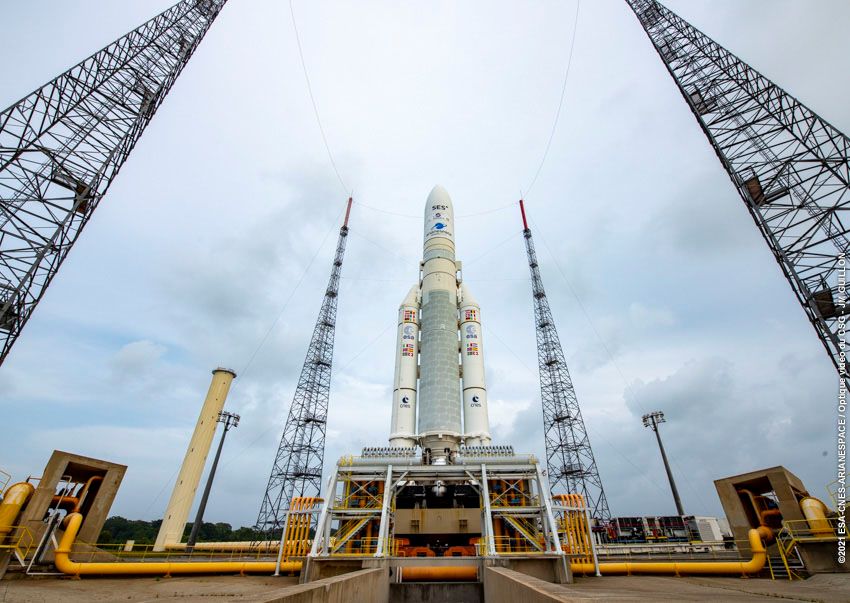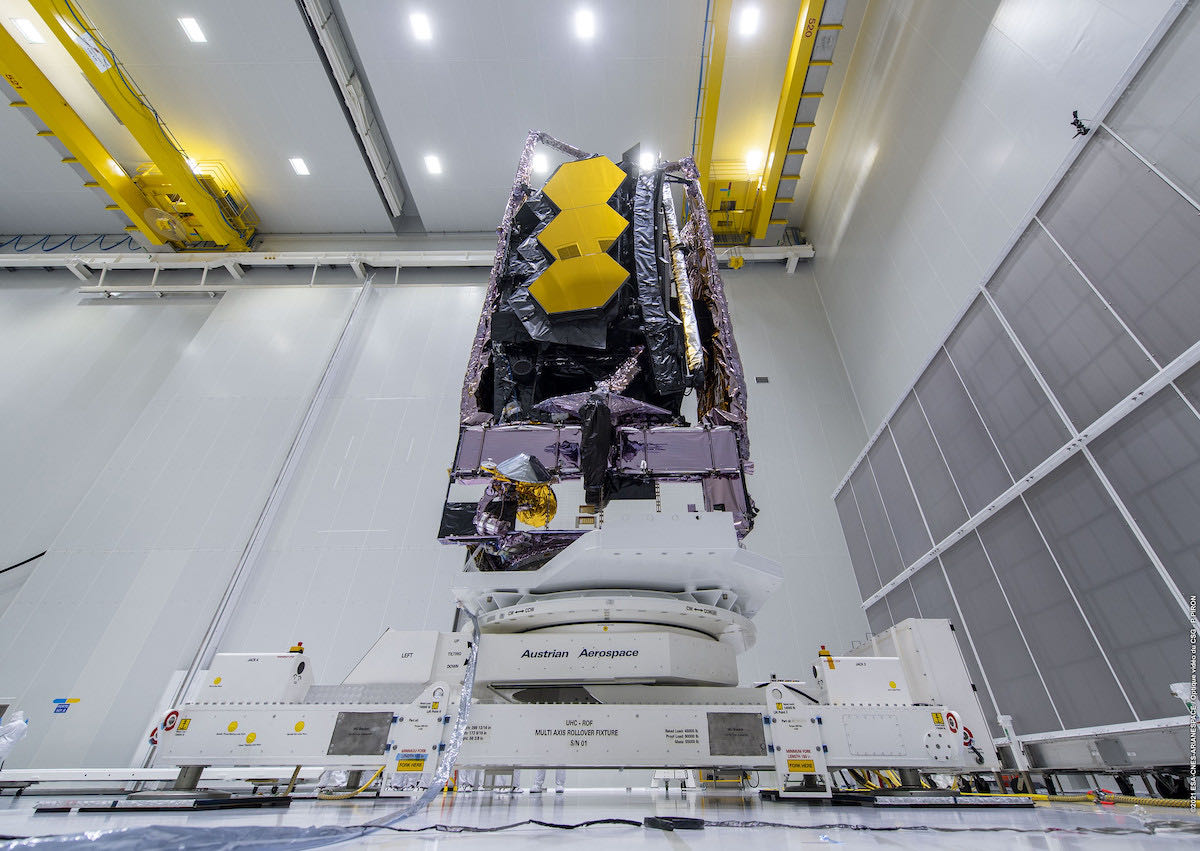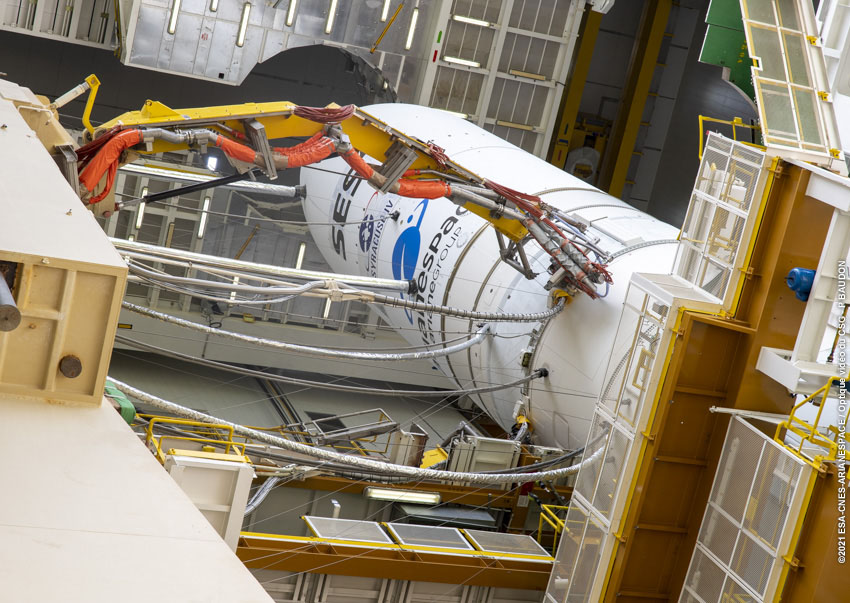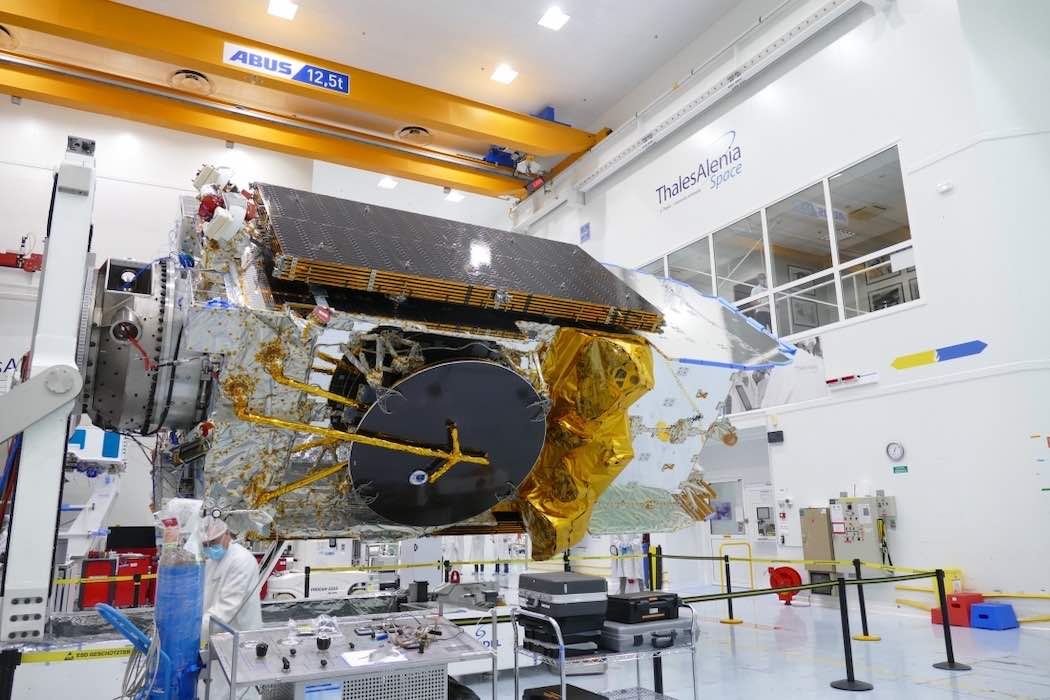
Arianespace is counting down to the blastoff of an Ariane 5 rocket Saturday night from French Guiana, the final flight of Europe’s workhorse launcher before NASA and the European Space Agency entrust it to launch the $10 billion James Webb Space Telescope.
Leaders from both agencies will be carefully watching the outcome of Saturday night’s mission with the commercial SES 17 satellite and the French military’s Syracuse 4A payload. The mission is the 111th flight of an Ariane 5 rocket since its debut in 1996.
NASA engineers helped ESA and Arianespace, the Ariane 5’s commercial operator, assess the rocket’s readiness to launch Webb, the most expensive robotic space mission in history. The launch Saturday is the final test before Webb is mounted to the next Ariane 5 for a liftoff scheduled for Dec. 18.
The Launch Services Program at Kennedy Space Center, which provides oversight for launches carrying NASA science missions to space, took on a consulting role for the James Webb Space Space Telescope.
“I think that helps calm some folks’ feelings, or perhaps perceptions, of why in the world are we launching this on a foreign vehicle,” said Omar Baez, a launch director at Kennedy, in a recent interview with Spaceflight Now.
The Ariane 5 is one of the most reliable launch vehicles in the world, with just one partial failure in its last 96 missions. The European Space Agency is paying for Webb’s launch as part of its contribution to the mission. NASA paid the bulk of Webb’s development costs, and the Canadian Space Agency is the third partner on the mission.
Baez said he took his first trip to the Ariane 5 launch base in Kourou, French Guiana, two decades ago to start evaluating facilities at the spaceport, which is managed by CNES, the French space agency.
“It’s touchy because you’re going up against Arianespace and CNES, and you’re a foreign agent, but we have worked well together,” Baez said.
He said NASA assigned experts in spacecraft processing, mission integration, and risk management as consultants to work with ESA and Arianespace ahead of Webb’s launch.

“Our risk manager has been following how the French and ESA folks bubble up any problems that Arianespace may have, and it’s very similar to the system we have here, with regard to insight and oversight by government agencies,” Baez said. “So we take credit for some of that insight by seeing that they have the same type of rigor that we show when we fly one of our precious payloads.”
The Ariane 5 rocket set to take off with SES 17 and Syracuse 4A rolled out to the ELA-3 launch pad Thursday at the Guiana Space Center in preparation for a launch attempt Friday night. But officials with Arianespace delayed the flight 24 hours to conduct additional checks on unspecified ground systems.
The launch window Saturday opens at 9:01 p.m. EDT (10:01 p.m. French Guiana time; 0101 GMT Sunday) and extends for 2 hours, 29 minutes. Fitted with two strap-on solid rocket boosters on each side of its hydrogen-fueled core stage, the Ariane 5 will launch two European-built communications satellites into an elongated geostationary transfer orbit.
In their analyses to ensure the Ariane 5 is ready to launch Webb, engineers in Europe and the United States have focused on the rocket’s Swiss-made payload fairing, or nose cone, which protects payloads during the first few minutes of flight through the atmosphere. The shroud jettisons in two pieces a few minutes after launch, exposing satellites for separation from the rocket once in orbit.

JWST will fold up origami-style to fit under the Ariane 5 rocket’s payload shroud, then unfurl solar panels, antennas, a segmented mirror array, and a thermal sunshield the size of a tennis court after separating from the Ariane 5 on the way to an observing post nearly a million miles (1.5 million kilometers) from Earth.
Once in position, JWST’s telescope — the largest ever flown in space — and four science instruments will peer into the distant universe, studying the turbulent aftermath of the Big Bang, the formation of galaxies and the environments of planets around other stars.
The Ariane 5 payload shroud is made by RUAG Space in Switzerland.
Engineers introduced modifications to the Ariane 5’s payload fairing to reduce vibrations imparted on the satellites during separation of the nose cone.
ESA, Arianespace and RUAG also changed the design of vents on the Ariane 5’s payload shroud to address a concern that a depressurization event could damage the Webb observatory when the fairing jettisons after liftoff. Engineers were concerned residual air trapped in Webb’s folded sunshield membranes could cause an “over-stress condition” at the time of fairing separation.
Baez said NASA engineers based at Kennedy Space Center were “very instrumental” in discovering an issue with how the Ariane 5 fairing depressurizes during ascent.
“We were able to, in cooperation with our French partners, instrument the fairing on previous flights that captured that environment and make sure that we had accurate information,” Baez said. “And, in fact, we did find a problem. We had to work on a scheme to be able to vent that fairing properly on its ascent.”

Built Thales Alenia Space, the SES 17 communications satellite will provide internet connectivity to airline passengers over the Americas, the Caribbean, and the Atlantic Ocean for SES of Luxembourg. The fully fueled satellite weighs 14,133 pounds (6,411 kilograms), according to Arianespace’s launch press kit.
SES 17 is the largest satellite ever procured by SES, and the largest spacecraft ever built by Thales. It carries a new digital payload controller, developed in a public-private partnership with ESA, that is capable of re-programming the satellites’s nearly 200 spot beams, adjusting power and frequency allocations to respond to changing customer needs.
The 8,492-pound (3,852-kilogram) Syracuse 4A spacecraft, also built by Thales Alenia Space, will provide communications services for the French military. The satellite will relay secure communications between French military aircraft, ground vehicles, and naval vessels, including submarines.
SES 17 is stacked in the upper position side the Ariane 5 payload fairing, and will separate from the rocket first at T+plus 29 minutes, 35 seconds. After jettison of a Sylda payload adapter, the Ariane 5’s cryogenic upper stage will maneuver to release Syracuse 4A at T+plus 38 minutes, 41 seconds.
The launch Saturday night will be the 111th flight of an Ariane 5 rocket, one of the most powerful operational launchers in the world. The Ariane 5 also has one of the largest payload fairings of any rocket, with a standard height of nearly 56 feet (17 meters) and a diameter of 17.7 feet (5.4 meters).
On Saturday night’s mission, the fairing’s position on the launcher is raised by 5 feet (1.5 meters) by the addition of a spacer section where the shroud connects to the Ariane 5’s upper stage. The change gives the rocket a total height of 184 feet (56.3 meters), making it the tallest Ariane 5 to ever fly.
The combined weight of the SES 17 and Syracuse 4A satellites is 22,626 pounds (10,263 kilograms). It’s the heaviest payload stack ever to be launched into geostationary transfer orbit, a typical drop-off orbit for geosynchronous communications satellites heading to an altitude of more than 22,000 miles (nearly 36,000 kilometers) over the equator.
The SES 17 and Syracuse 4A satellites will use their own engines to reach their final operating orbits.
Email the author.
Follow Stephen Clark on Twitter: @StephenClark1.
